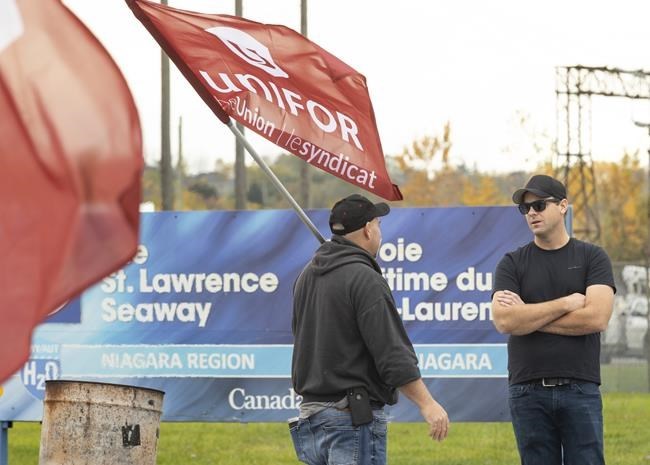A strike that shuttered operations through the St. Lawrence Seaway for the past week came to an end on Sunday as both the union and employer announced they had reached a tentative contract with help from federal mediators.
Neither the St. Lawrence Seaway Management Corp. nor Unifor — which represents about 360 seaway employees — shared details of the proposed agreement, but both sides were under pressure to resolve the strike that halted the shipment of cargo through the heavily-travelled corridor.
The premiers of Ontario and Quebec had called on Ottawa to intervene if federally mediated talks failed to bring about a quick end to the walkout by Unifor members at most of the seaway's 15 locks.
But on Sunday evening, both the union and the seaway authority issued statements saying a tentative deal had been achieved.
“I am so proud of the unity of our members along the seaway as they joined together to secure better wages and working conditions for all,” Unifor Quebec Director Daniel Cloutier said in the union's news release.
The Seaway Management Corp. said it will begin implementing its recovery program immediately and will start "passing ships progressively" as of Monday, adding employees will be back on the job by 7 a.m.
Terence Bowles, president and CEO of the Seaway Management Corp., said the agreement was "fair for workers" and "secures a strong and stable future for the seaway."
“We know that this strike has not been easy for anyone, and value the patience and co-operation of our marine industry bi-national partners; carriers, shippers, ports, local communities and all those who depend on this vital transportation corridor on both sides of the Canada-U.S. border," Bowles said in a statement from the seaway authority.
Unifor said details of the tentative agreement will first be shared with members and will be made public once it has been ratified in a vote that will be scheduled in the coming days.
Wages have been a key sticking point in the job action, which shut down the seaway last weekend.
The seaway is a major trade route connecting the Great Lakes with the Atlantic Ocean.
In a joint statement Thursday, Ontario Premier Doug Ford and Quebec Premier Francois Legault said they were pleased the two parties were set to return to the negotiating table alongside federal mediators Friday, but urged Ottawa to use whatever tools it had on hand to bring about a resolution should an agreement fail to emerge immediately.
Both Ford and Legault warned that businesses and people across the country would soon feel the ripple effects of the disruption, with tens of millions of dollars in economic activity lost every day.
They said they could have a repeat of the B.C. port workers strike, which halted the flow of goods for 13 days in July.
Federal Labour Minister Seamus O'Regan thanked the union, the employer and federal mediators for their "commitment to the negotiating table."
The Canadian Chamber of Commerce also welcomed the announcement of an agreement.
"While it is positive that the two parties were able to reach a negotiated agreement, this latest strike is further proof that the federal government needs more tools to ensure labour stability for our critical infrastructure and supply chains," the chamber's president and CEO, Perrin Beatty, said in a news release.
"We look forward to working with members of Parliament to ensure our supply chains are reliable and protected."
The seaway, which runs for 300 kilometres between Lake Erie and Montreal, carried $16.7 billion worth of cargo last year, much of it grain, iron ore, stone and road salt.
This report by The Canadian Press was first published Oct. 29, 2023.
Rob Drinkwater, The Canadian Press



